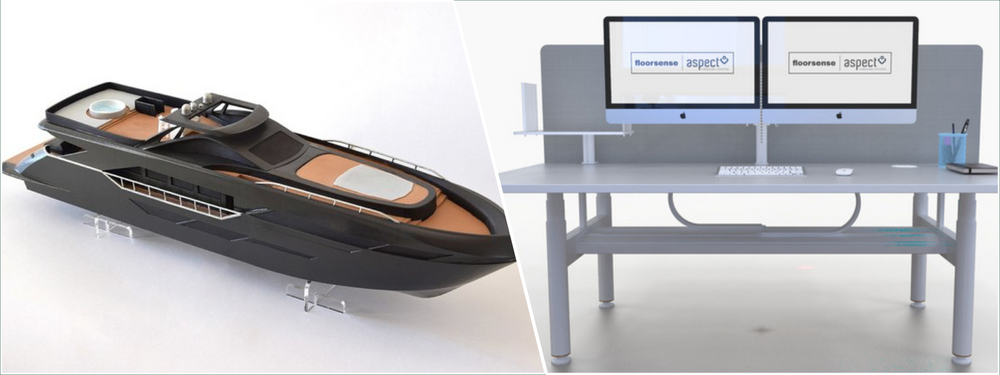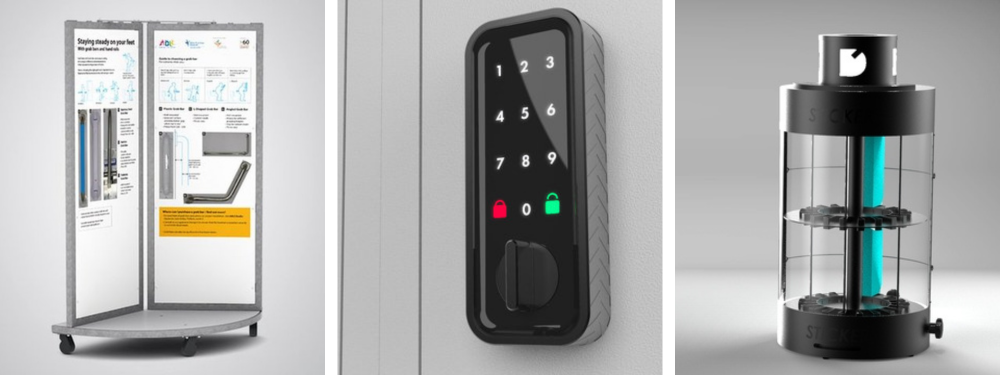Excellent product development results from the expertise of a product development expert. Starting with a rough concept, the iterative process involves meticulous engineering work, evaluation, modification, and validation. A product development cycle follows a repetitive process of designing, building, testing, refining, manufacturing, and improving—in that particular order. Prototypes are integral to the product development cycle and are created as pre-production samples or representations of the final product design.
There can be multiple prototypes built during the development of a single product. Each is used as an object to be analyzed and scrutinized to find room for improvement. A prototype bridges the different phases of a product development process.
While the idea behind creating a prototype has been the same forever, the prototyping methods have advanced. Prototyping has become much faster and more accurate than it was previously. Although some companies still employ the traditional approach to fabrication, such as handcrafting, the tools have also been updated. In general, modern prototyping methods enable engineers and designers to build and iterate designs in a more time-efficient fashion.
 Table of contents
Table of contents
RELATED: How to make a prototype for your new product design

Prototypes for different development stages
As a preliminary product model, a prototype—by definition—doesn’t have all the desired characteristics of the intended design. Even when labeled as a “final prototype,” the build will likely need some tinkering before it enters production. The development process typically goes through four prototype versions throughout a product’s journey from ideation to mass manufacturing.
- Proof-of-Concept
The first in the line is a proof-of-concept (PoC) prototype, which aims to demonstrate the technical feasibility of an idea for a product and that there is a market for it. Built early in the design process, a PoC focuses on form factor and dimension. It might include basic functionality but only to validate the product idea, and then the development can move forward to subsequent stages.
- Looks-like prototype
The aesthetic is the primary concern of a looks-like prototype, which addresses essential design elements like ergonomics, ease of use, and appearance. The purpose is to give a clear idea of how the final product should look. It is a mock-up representing the product’s outer shell (not to be confused with packaging).
Although the prototype at this stage lacks functionality, the build carries nearly all the superficial design elements. Once validated and approved, the development team can focus on the product’s features and internal mechanisms as part of their new product design services.
Creating a looks-like prototype almost starts with a rough sketch. It is common for a company to employ a traditional handcrafting method to build the model from plain materials like clay or foam. The prototype may undergo multiple revisions because a product’s aesthetic aspect is arguably as important as its features and functionality. It goes back and forth between mock-ups and digital drawings until the design is perfected. Some companies have abandoned making physical looks-like models in favor of an all-digital approach. When the final iteration is fabricated, the prototype should use the same materials, colors, and finishes specified for the product.
- Functional (works-like) prototype
Running parallel to developing a looks-like prototype, engineers build a similar model equipped with the inner workings. Depending on the product, the model can be fitted with electronic components, mechanical parts, or a combination of those systems. The prototype might look different from the final product, but it has the core technology and functionality to make everything work.
Now that there is an operable model, prototype engineers can put it through test runs, evaluate its performance, and refine the systems if need be. In the development process of a complex product, every sub-system is often constructed and analyzed by a separate engineering team. A set of predetermined parameters governs the collective effort to make sure the assemblies are compatible. Such a framework allows for straightforward identification of any flaw in the system; when something doesn’t work as intended, it is easy to isolate the problem and address the issue.
- Engineering prototype
The final iterations of looks-like and works-like models come together as an engineering prototype. This process is a collaborative endeavor, achieved with the help of our prototype design engineering services. Here, concessions from both sides are made to yield a prototype that appears and performs like a ready-to-market product. It is the concluding iteration before the product goes to production.
An engineering prototype is built as a one-off model as the final product’s best possible representation in aesthetic and functional aspects. It is fabricated from engineer-approved materials under the already verified designs. As mentioned earlier, the final prototype may require further production feasibility validation from the manufacturer. However, changes to product specifications are usually minimum because they are only meant to increase manufacturing efficiency instead of modifying the design.
RELATED: 5 ways how rapid product development & prototyping benefits your company

Prototyping methods
There is a different prototyping method for every prototype version required for product development. Each version represents progress, from proof of concept to the final iteration. As product development progresses, the design inputs are complex, and the corresponding prototype becomes more sophisticated. This is where product prototyping experts come in. They can help a company tap into various fabrication techniques to meet a specific model’s requirements. Their expertise is pivotal in accurately translating the design into a functional prototype.
Handcrafting
A rudimentary physical mock-up is likely efficient as a proof-of-concept. Also known as a low-fidelity prototype, the mock-up is intended as the simplest manifestation of a product idea, and it doesn’t have to be pretty or functional at all. The model is acceptable if it represents a basic spatial concept in 3D form—regardless of how unrefined it might be. Therefore, handcrafting is a time-efficient and budget-friendly method to do the job.
Engineers can use materials like cardboard, wood, or modular toys like LEGO. In fact, the material types are unimportant; engineers may take the necessary components from existing products and glue them together. The result may look like duct tape and baling wire, but none of that matter if the model serves its intended functions well.
A crude prototype is not meant as a working model; it only needs to resemble the product in question remotely to set the direction of the design thinking process. Any cheap, readily available material and easy to manipulate will do. In case more rigid materials are necessary, the handcrafting process may require the use of power tools. Continuous materials (such as foam core or wood) give greater freedom in creativity and may lead to a more accurate depiction of a spatial concept than modular toys.
Subtractive manufacturing
The most common example of subtractive manufacturing is CNC (Computer Numerical Control) machining, which involves subtracting materials to build an end product. The process usually begins with a solid block of metal or plastic, shaped by removing the unnecessary portion of it through cutting, grinding, or drilling.
Some prototypes require multiple separately CNC-machined parts to be assembled into a single model. Subtractive manufacturing, an area in which CNC machine design experts excel, works with CAD software and produces high-precision parts from various soft and hard materials. Water jet cutting is another form of CNC that works with more materials, from stainless steel to glass. Subtractive manufacturing offers all the features you need to build works-like prototypes, but it might be overkill for a proof-of-concept.
Additive manufacturing
If CNC is a rapid subtractive manufacturing technique, 3D printing is the additive counterpart. 3D printers build three-dimensional parts layer by layer until the desired shape is formed. The printed model is created as a CAD image, usually in STL file format. Not every 3D printer is created equal; the options are listed below.
- Fused Deposition Modeling (FDM): FDM is the extrusion of molten thermoplastic filament through a printer nozzle over a build plate. As the filament cools down, it quickly solidifies and forms the model.
- Vat Polymerization: rapid prototyping services use liquid resin as the base material. A light source solidifies specific points on the material to create three-dimensional parts.
- Sheet Lamination: thin-layer materials are stacked and laminated together using either light or sound energy to build a 3D object. It works with metal, polymer, and paper.
- Powder Bed Fusion: thermal energy selectively binds powder particles to build a 3D object. It heats them to a point where the powdered materials (plastic, metal, or ceramic) fuse on a molecular level.
- Material Jetting: multiple types of resin (as wax droplets) harden when exposed to light and build three-dimensional parts. It can print objects in various colors and textures.
- Binder Jetting: powered materials (sand, ceramic, metal, plastic, or a combination) are hardened using liquid glue to build accurate high-density 3D parts layer by layer.
- Directed Energy Deposition (DED): metal powder or wire is melted and deposited at the same on a build plate through a nozzle. The heat source can be a laser, plasma, or electron beam.
The printing time is relatively quick regardless of technology, even for a complex object. Most printed models require additional post-processing, for example, color application and finishing.
CNC and metal 3D printing design services are not cheap, but outsourcing at least permits per-settled cost and reduces in-house strain. For small businesses without the facilities or tools to build functional and engineering models, prototype manufacturing services can access the required processes without heavy equipment and labor investments.
RELATED: 10 tips when hiring a prototype design firm for new product design
How Cad Crowd can help
Are you trying to find the perfect prototyping method for your next product development project? Look no further! Cad Crowd’s group of experts is here to guide you through the maze of prototyping methods. From additive manufacturing to subtractive manufacturing, our experienced professionals have the know-how to ensure the precision and quality of your prototypes.
Don’t wait to make your product development journey smoother and more efficient. Request a free quote from Cad Crowd today and explore the potential of our exceptional prototyping services. Your journey to successful product development starts with Cad Crowd!
